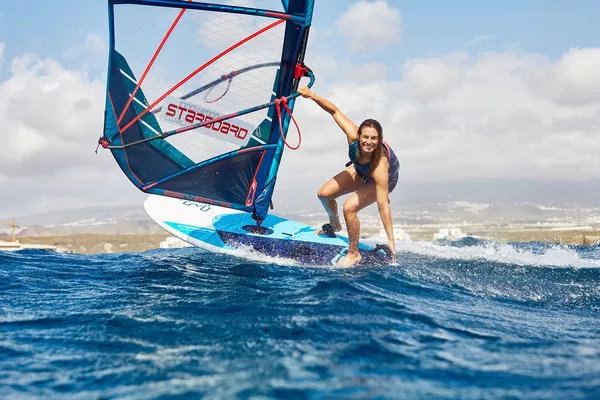Windsurfing, a thrilling fusion of sailing and surfing, offers an exhilarating experience on the water. Whether you’re drawn to its sense of freedom, the rush of adrenaline, or the challenge of mastering a new skill, windsurfing has something to offer for everyone. However, like any sport, it requires patience, practice, and proper technique to truly enjoy. If you’re a beginner looking to embark on this exciting journey, this guide is tailored just for you.
Understanding the Essentials: Equipment and Gear
Before hitting the water, it’s crucial to understand the basic equipment and gear needed for windsurfing:
1. Board: Windsurfing boards come in various shapes and sizes, catering to different skill levels and wind conditions. For beginners, a wide, stable board with a volume of 150-200 liters is recommended, as it provides better stability and buoyancy, making it easier to balance and maneuver.
2. Sail: The size of the sail depends on wind conditions and the rider’s weight. As a beginner, start with a smaller sail (around 3.5 to 5.5 square meters) in light to moderate winds. Larger sails provide more power but can be challenging to control for novices.
3. Mast, Boom, and Mast Foot: These components connect the sail to the board. The mast provides vertical support, while the boom allows the rider to control the sail’s angle and power. The mast foot attaches the sail to the board and acts as a pivot point for steering.
4. Wetsuit and Safety Gear: Depending on water temperature, wearing a wetsuit is advisable to stay warm and protected. Additionally, always wear a personal flotation device (PFD) and a helmet for safety.
Learning the Fundamentals: Basic Techniques
1. Getting on the Board: Start by wading into shallow water with the board perpendicular to the wind. Position the sail upright with the wind blowing into it. With one hand on the mast and the other on the boom, carefully step onto the board, keeping your weight centered.
2. Balancing and Stance: Achieving balance is key to staying upright on the board. Keep your knees slightly bent and your weight centered over the board’s midpoint. Maintain a relaxed stance, with your feet shoulder-width apart and parallel to the board.
3. Steering and Turning: To steer the board, shift your weight towards the back to turn downwind and towards the front to turn upwind. Use gentle movements and gradual weight shifts to control the direction. Practice turning in both directions until you feel comfortable.
4. Harnessing the Wind: Learning to harness the wind’s power is essential for propulsion. Angle the sail slightly away from the wind to catch it effectively. Use your back hand on the boom to apply pressure and control the sail’s angle, while the front hand maintains balance and stability.
5. Tacking and Gybing: Tacking involves turning the board through the wind while changing direction, while gybing is a downwind turn. Practice these maneuvers in open water, focusing on smooth transitions and maintaining control of the sail.
Safety Tips and Precautions
Check Weather Conditions: Before heading out, check weather forecasts and wind conditions to ensure safe and enjoyable windsurfing.
1. Stay within Limits: Start in calm waters with light winds and gradually progress to stronger winds as you gain experience. Avoid windsurfing in stormy or unpredictable weather.
2. Learn to Self-Rescue: Practice self-rescue techniques, such as uphauling the sail or body dragging back to shore, in case of emergencies.
3. Be Aware of Hazards: Watch out for obstacles such as rocks, buoys, and other watercraft. Maintain a safe distance from shore and other windsurfers to prevent collisions.
4. Respect Nature: Windsurfing takes place in natural environments, so be mindful of marine life and ecosystems. Avoid disturbing wildlife and dispose of trash responsibly.
Progressing and Refining Your Skills
As you become more comfortable on the board, challenge yourself to try new techniques and maneuvers. Take lessons from certified instructors to receive personalized guidance and feedback. Joining windsurfing clubs or communities is a great way to connect with fellow enthusiasts and share experiences. Remember, mastering windsurfing is a journey that requires dedication and perseverance, but the rewards of gliding across the water propelled by wind and skill are incomparable.
Conclusion
Windsurfing offers a unique blend of adventure, athleticism, and connection with nature. With the right equipment, techniques, and safety precautions, beginners can embark on this exciting journey with confidence. Start by mastering the basics, gradually progressing to more advanced skills, and always prioritize safety above all else. So, grab your board, catch the wind, and let the thrill of windsurfing propel you into a world of endless possibilities on the water.

